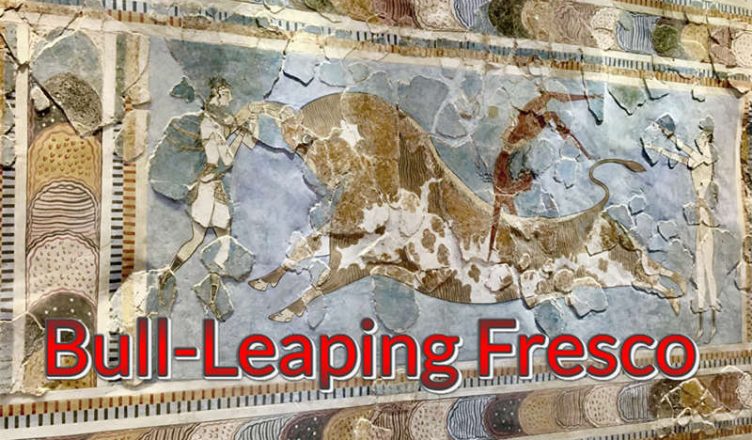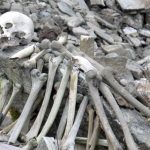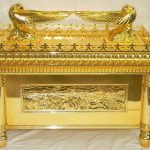We know that painting was highly valued by the Greeks, as evidenced by the numerous descriptions of contemporary painters and their works. These descriptions, also known as ekphrasis, formed an essential part of education for young people during the Hellenistic period (323 – 33 BCE). The aim of ekphrasis literature was to translate the visual qualities of paintings into written language so that readers could leave with an impression of the artwork similar to what they would have seen with their own eyes.
The only extensively surviving form of Greek painting, vase painting, is not mentioned in this document, indicating that it was considered a lower form of art. Instead, the most frequently discussed types of painting—panel or mural paintings—have hardly survived. Museums in Candia and Athens display murals from the city of Knossos on the island of Crete. These murals, dating back to around 1500 BCE, employ strong outlines, flat colors, and decorative patterns reminiscent of vase paintings.
Dr. Eleanor Rand, writing for the Pennsylvania Museum, notes that the murals in Knossos were painted with pigments imported from Egypt. Therefore, their influence from Egyptian traditions is not surprising. For instance, in the so-called “Bull-Leaping Fresco,” females are depicted in white, while males are depicted in brown. “Crete was an artistic center,” Rand continues, “artists and craftsmen from Crete traveled far and wide, decorating palaces for lords of other nations.”
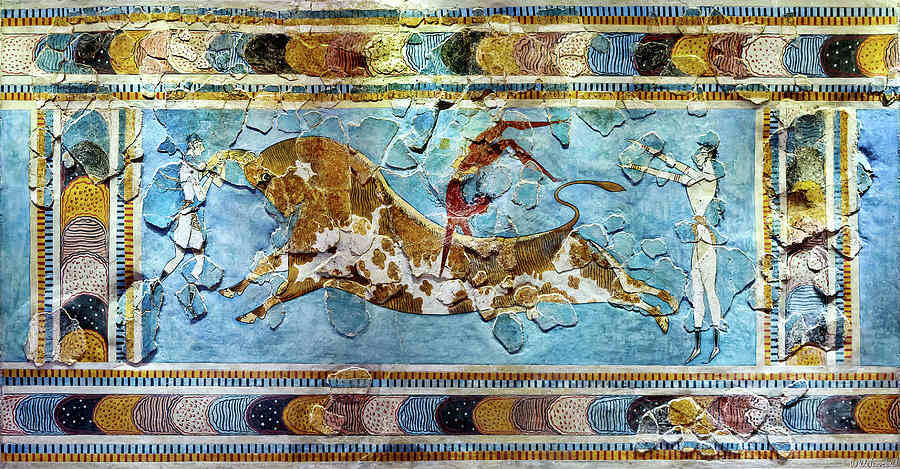
Unraveling the Mysteries of the Bull-Leaping Fresco: Minoan Art, Rituals, and Symbolism
The Bull-Leaping Fresco, as it is called, is the most extensively restored among several plaster panels originally located on the upper part of the east wall of the Knossos Palace on the island of Crete. It depicts a scene of bull-leaping. Despite being murals, they are painted on a plaster relief scene, making them challenging to produce. Artists had to manage not only the height of the panels but also shape and paint them while the fresh plaster was setting. Therefore, these panels do not represent the developmental stages of this technique. In terms of the Minoan chronology, their polychromatic tones—white, light red, deep red, blue, and black—exclude them from the Early Minoan (EM) and Early Minoan Middle (MM) periods. In other words, they are examples of “mature art” created no earlier than MM III.
In the Late Minoan (LM) II period, possibly due to an earthquake during the destruction of the palace, the damaged panels fell from the upper level to the ground. By that time, they had already fallen into disuse in the adjacent east staircase area and were partially damaged.
The theme of bull-handling is common in Minoan art and represents one of the figures dealing with bulls. Arthur Evans, the curator of the Ashmolean Museum and excavator-in-chief of the palace, introduced this theme in the third chapter of his seminal work on Knossos and Minoan civilization, the Minoan Palace. There, he referred to these murals as the “Bull-Leaping Frescoes.”
There are more fragments than the famous reconstruction, suggesting several scenes of bull-leaping. A proposed reconstruction by M. Cameron includes four very similar scenes, each featuring a bull facing left and three human figures, one inverted on the back of the bull, and one at each end, holding the bull’s horns.
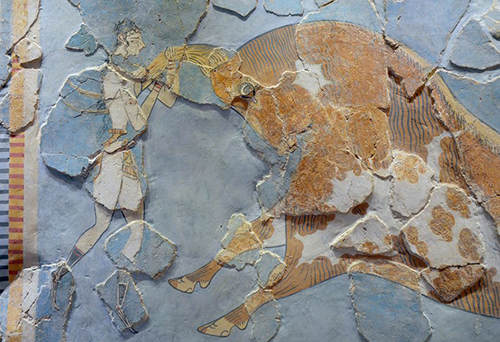
Arthur Evans recognized that the depiction of bulls and bull-taming has a long tradition, with numerous examples in multimedia art not only in Knossos and other parts of Crete but also in the Aegean and mainland Greece, and even with roots in Egypt and the Middle East. In Knossos, he distinguished between “bull-ring scenes” or “public ‘cowboy’ exploits” and “circus sports.” Cowboy scenes depict the capture and handling of wild bulls, represented by animal icons that closely resemble wild bulls, symbolizing the taming of the mother bull. This bull pattern appears in the plaster murals at the north entrance of the palace. Furthermore, Jordan Wolfe of Furman University explained the significance of bull-leaping behavior in Minoan culture, emphasizing the human suspicion of mastering nature.
Circus sports stand in stark contrast to bullfighting. They are “a more structured and ritualized form of sport, inherently confined to a specially designed structure.” He speculates further that “the palace bull-ring itself would have been located on the beach below.” Therefore, the Taureador murals are not real-time depictions of actual events but decorative patterns on the wall above the ritual bullring. They portray a traditional stock scene later referred to as “bull-leaping.” It still lacks a definitive definition. Although it vaguely brings to mind the act of leaping over a bull, a century after the discovery of the murals, the technique and the reasons for doing so remain unclear.
Minoan Marvel: Bull-Leaping Fresco Reveals Ancient Coming-of-Age Ritual
The “Bull-Leaping Fresco,” excavated and restored from the Knossos Palace, is housed in the Heraklion Archaeological Museum on the Greek island of Crete. The series of actions, including “leaping, grabbing the bull’s horns, and flying over the bull’s back,” depicted in this mural, represent the movements young men needed to perform during their coming-of-age ritual in Minoan civilization. Originating from the Knossos Palace on the island of Crete, this fresco vividly presents three young men and women engaging in the ritual activity of bull-leaping.
In 1899, the British archaeologist Sir Arthur Evans initiated the excavation and restoration of the Knossos Palace. He believed the palace was the cultural center of Crete in the 16th century BCE and the capital of the mythical King Minos in Greek mythology. The intricate passages and winding staircases inside the Knossos Palace, creating a maze-like impression, led Evans to conclude that the discovered palace was the actual location of the mythical Minotaur’s labyrinth. The Minoan culture, one of the earliest ancient cultures around the Aegean, was once considered mythical until just over a century ago.
Returning to the mural, the delicate waists and gracefully curved lines of the figures, along with the harmonious decorative borders and overall dynamic sense in the artwork, reflect typical Minoan art of the period. Observing the details, the female on the left (usually distinguishable by the skin color, with females portrayed in white and males in brown) is grabbing the horns of the charging bull and leaping over its back, the most commonly described action. However, Evans consulted athletes practicing this sport and discovered that it was practically impossible to grab the bull’s horns at the right angle when it was running forward. The male figure in the center is performing a somersault over the bull’s back and is about to land behind it. The curvature of his body conveys a sense of speed and dynamism. In some contemporary artworks, the bull-leaper is shown landing with both feet on the bull’s back, a highly debated aspect of this “coming-of-age” athletic activity.
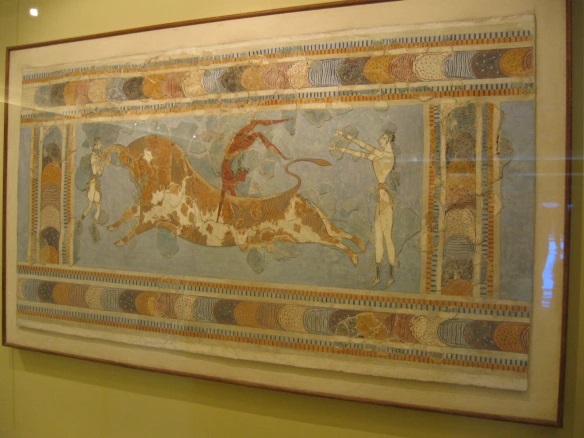
Does the “Bull-Leaping Fresco” authentically portray the coming-of-age ritual in Minoan civilization, or does it simply depict the excitement, speed, and youthful courage of this activity through dynamic patterns and lines? Upon close observation, one can even notice glistening tears beneath the bull’s eye – are these tears of surrender or acceptance? In reality, when facing a painting from around 1500 BCE, as long as the image continues to captivate and spark boundless imagination, these questions seem less significant.
In the 4th century BCE, as vase painting declined, mural painting flourished. Art historian Robert Manuel Cook detailed in his work “Greek Art: Its Development, Characteristics, and Influence” how Greek artists of the time developed “all the technical devices necessary for a completely illusory painting.” These devices included perspective adjustments, the use of color to imply distance, shading, foreshortening, and other techniques that reappeared during the Renaissance.
Even sculpture once incorporated painted elements. When we think of Greek statues, we often envision male and female figures carved from pure white marble. However, in the past, this whiteness was covered by pigments conveying vibrant-colored garments and a range of Mediterranean skin tones. According to an article in The New Yorker, the study of these pigments has proven difficult due to the contemporary “assumptions about race and aesthetics tied to the colorless ruins.”
Vivid Vistas: Unveiling Roman Opulence Through Campanian Frescoes
Most surviving Roman paintings are frescoes, and the best-preserved ones were found in Campania, an area covered by the ash of Mount Vesuvius in 79 AD. These artworks once adorned the walls of villas in Boscoreale and Boscotrecase, offering a richer glimpse into the opulent lifestyles of the Romans than written records. They feature images of small groves, passageways, coastlines, porticos, and landscaped gardens, showcasing enticing scenes of various landscapes.
According to an article from the Metropolitan Museum of Art, Roman painting can be divided into four distinct styles that evolved over time. The first style, spanning from around 200 BC to 60 BC, “primarily involved the exploration of simulating various colors and types of marble on painted plaster.” This means that early Roman paintings, similar to early Greek paintings, initially attempted to replicate effects already achieved through other art forms.
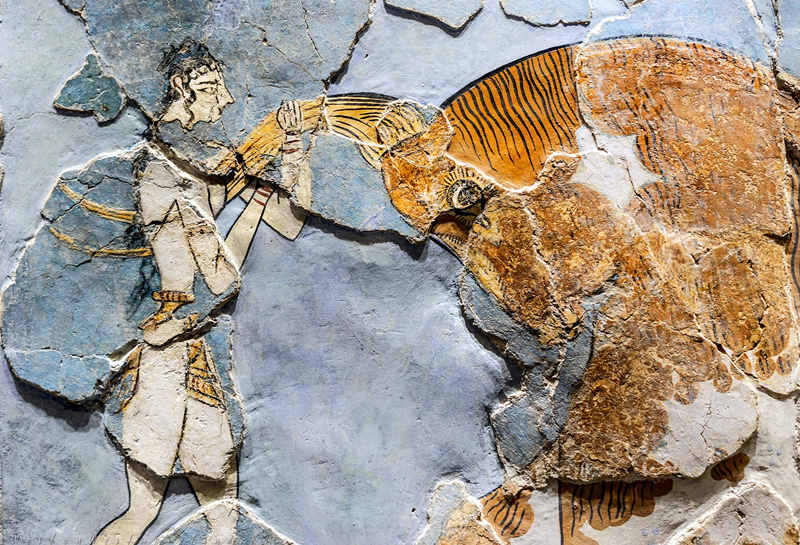
The second style, which emerged in the 1st century BC, continued this trend. “Mural artists,” the article continues, “purely imitated architectural forms through painting.” There was a shift from plaster to plaster, and painters began using shading and perspective to imply depth. Some frescoes were painted to appear as if seen through windows, embedding them into the architecture, turning a room into a “kind of gallery.”
The third style (20 BC to 20 AD) was essentially the court style of Emperor Augustus, who succeeded Julius Caesar, transforming Rome from a republic into an empire. “Originating from an impulse for innovation rather than recreation,” this style “eschewed fantasy in favor of surface ornamentation.” Shadows and perspective gave way to monochromatic backgrounds, upon which natural images were painted, with figures serving as decoration rather than dominant elements.
END:
As we reflect on the captivating journey through the Bull-Leaping Fresco, one cannot help but anticipate its future impact on our understanding of Minoan civilization. The ongoing advancements in archaeological techniques and interdisciplinary studies promise to unveil even more layers of insight hidden within the brushstrokes of this ancient masterpiece. Scholars and researchers, inspired by the enigmatic scenes of youthful courage and dynamism, continue to explore the ritual significance and cultural nuances embedded in each detail.
The Bull-Leaping Fresco stands not only as a window into the past but also as a bridge to the future of archaeological exploration. With evolving technologies and a deepening appreciation for the interplay between art and ritual, we can expect further revelations that will enrich our comprehension of Minoan society and the intricate tapestry of its coming-of-age ceremonies. As new discoveries unfold, the Bull-Leaping Fresco remains an enduring symbol, inviting us to leap into the unknown realms of history and culture, forever influencing our perceptions of an ancient civilization that thrived in the Aegean breeze.
More UFOs and mysterious files, please check out our YouTube channel: MysFiles
Lacerta Files: Human beings are the product of genetic engineering by alien civilizations.
